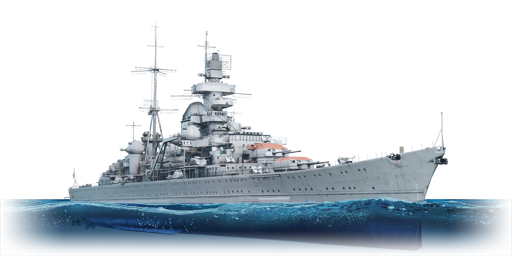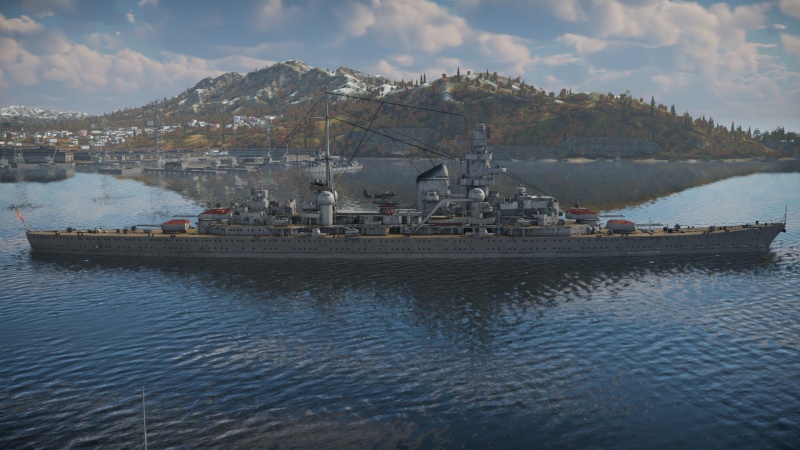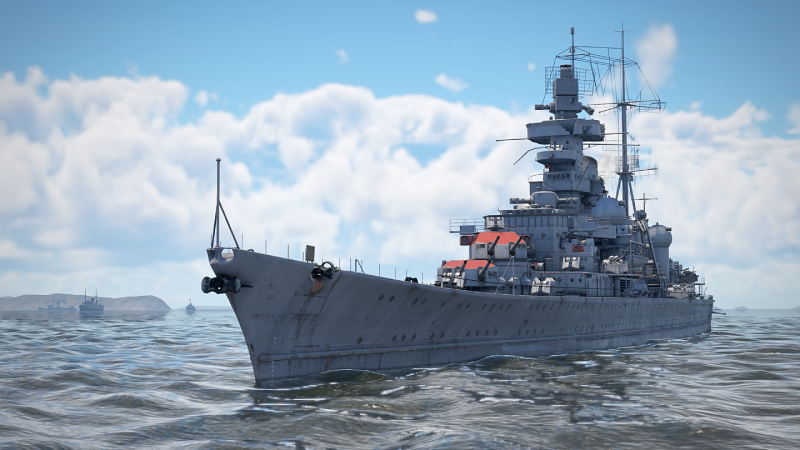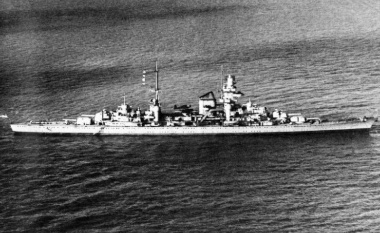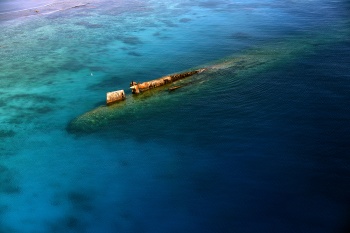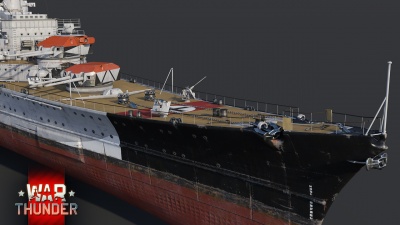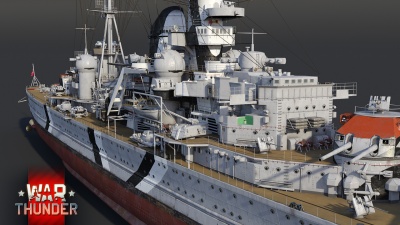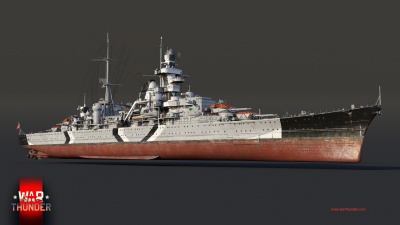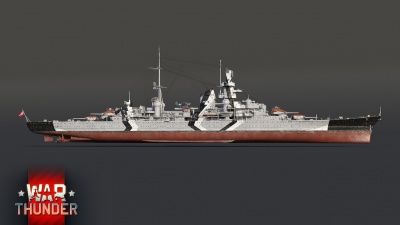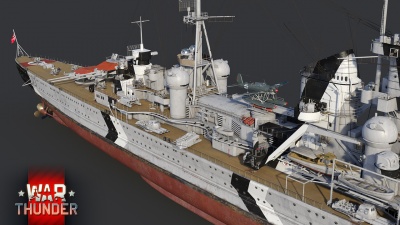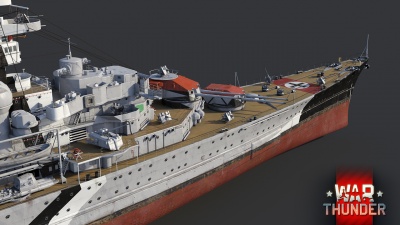Difference between revisions of "Prinz Eugen"
(→Description) |
U105837429 (talk | contribs) m (→Description: availability) |
||
| (3 intermediate revisions by 3 users not shown) | |||
| Line 8: | Line 8: | ||
The '''{{PAGENAME}}''' was the third of the ''[[Admiral Hipper (Family)|Admiral Hipper]]''-class heavy cruisers and the last to be completed by the Kriegsmarine. She was ordered from the Krupp Germaniawerft shipyard in Kiel and was laid down on 23 April 1936 as part of the German rearmament programme following the Anglo-German Naval Agreement a year prior, and was later launched on 22 August 1938. | The '''{{PAGENAME}}''' was the third of the ''[[Admiral Hipper (Family)|Admiral Hipper]]''-class heavy cruisers and the last to be completed by the Kriegsmarine. She was ordered from the Krupp Germaniawerft shipyard in Kiel and was laid down on 23 April 1936 as part of the German rearmament programme following the Anglo-German Naval Agreement a year prior, and was later launched on 22 August 1938. | ||
| − | After being commissioned in 1940 and patrolling around the Atlantic alongside the battleship ''Bismarck'' in early May 1941, ''Prinz Eugen'' would take part in her most famous engagements in the Battle of the Denmark Strait later that month, in which the pair managed to sink the British flagship [[HMS Hood|HMS ''Hood'']] and damage the battleship ''Prince of Wales''. However, ''Eugen'' suffered a fuel tank leak and was forced to part ways with ''Bismarck'', leaving the latter to her demise a few days later. After emergency repairs and problems with her engines and turbine, ''Prinz Eugen'' was ordered to be docked in Brest, occupied France, for extensive repair. After spending half a year in Brest and being the target of frequent air raids by the RAF, ''Prinz Eugen'', along with | + | After being commissioned in 1940 and patrolling around the Atlantic alongside the battleship ''Bismarck'' in early May 1941, ''Prinz Eugen'' would take part in her most famous engagements in the Battle of the Denmark Strait later that month, in which the pair managed to sink the British flagship [[HMS Hood|HMS ''Hood'']] and damage the battleship ''Prince of Wales''. However, ''Eugen'' suffered a fuel tank leak and was forced to part ways with ''Bismarck'', leaving the latter to her demise a few days later. After emergency repairs and problems with her engines and turbine, ''Prinz Eugen'' was ordered to be docked in Brest, occupied France, for extensive repair. After spending half a year in Brest and being the target of frequent air raids by the RAF, ''Prinz Eugen'', along with battleships ''[[Scharnhorst]]'' and ''Gneisenau'', was ordered to break through the English Channel in January 1942. The next month, ''Eugen''<nowiki/>'s stern was struck by a torpedo from the submarine HMS ''Trident'', resulting in extensive damage to the rudder. After completing her repair in 1943, ''Prinz Eugen'' was sent to the Baltic Sea to provide fire support for the retreating German army on the Eastern Front, which she did until the German capitulation in 1945. She and ''[[Nürnberg]]'' were the only German bluewater warships to survive the war intact. |
After the war, ''Prinz Eugen'' was later awarded to the United States as reparation. The US Navy subsequently conducted extensive examinations on various German machinery. After which, ''Prinz Eugen''<nowiki/>'s career literally ended with a bang when she was used as one of the targets for the Operation Crossroads nuclear tests in 1946. | After the war, ''Prinz Eugen'' was later awarded to the United States as reparation. The US Navy subsequently conducted extensive examinations on various German machinery. After which, ''Prinz Eugen''<nowiki/>'s career literally ended with a bang when she was used as one of the targets for the Operation Crossroads nuclear tests in 1946. | ||
| − | + | The '''{{PAGENAME}}''' was introduced as a premium pack in [[Update 1.95 "Northern Wind"]]and was removed from the store after the [[wt:en/news/8880-shop-may-sale-in-the-gaijin-store-en|2024 May sales]]. It has since been made available for Golden Eagles {{GE}} in the 2024 [[wt:en/news/9032-shop-prinz-eugen-temporarily-returns-to-celebrate-the-anniversary-of-its-launch-en|Launch Anniversary Celebration]] mini event. | |
| + | |||
| + | It is perhaps one of the most famous cruisers of World War II. Compared to her sister ship, ''[[Admiral Hipper]]'', ''Eugen'' is in her final 1945 configuration with a substantial increase in AA firepower and crew count. This is effectively a double-edged sword; on one hand, she is more survivable than her sister ship and better protected against aircraft, while on the other hand, her large amounts of AA mounts mean that she will frequently catch fire whenever hit. Aside from this, ''Eugen'' is largely the same as ''Hipper'' in playstyle, being an all-around heavy cruiser with a particular focus on her high-velocity 8-inch guns, capable of engaging any targets she could face. | ||
== General info == | == General info == | ||
| Line 18: | Line 20: | ||
{{Specs-Fleet-Armour}} | {{Specs-Fleet-Armour}} | ||
<!-- ''Talk about the vehicle's armour. Note the most well-defended and most vulnerable zones, e.g. the ammo magazine. Evaluate the composition of components and assemblies responsible for movement and manoeuvrability. Evaluate the survivability of the primary and secondary armaments separately. Don't forget to mention the size of the crew, which plays an important role in fleet mechanics. Save tips on preserving survivability for the "Usage in battles" section. If necessary, use a graphical template to show the most well-protected or most vulnerable points in the armour.'' --> | <!-- ''Talk about the vehicle's armour. Note the most well-defended and most vulnerable zones, e.g. the ammo magazine. Evaluate the composition of components and assemblies responsible for movement and manoeuvrability. Evaluate the survivability of the primary and secondary armaments separately. Don't forget to mention the size of the crew, which plays an important role in fleet mechanics. Save tips on preserving survivability for the "Usage in battles" section. If necessary, use a graphical template to show the most well-protected or most vulnerable points in the armour.'' --> | ||
| − | As with her sister ship [[Admiral Hipper]], the {{PAGENAME}} features some of the best protection of all cruisers in the game. Her hull is covered with several layers of armour in "turtleback" layout specifically designed to soak up and contain a lot of damage, save for some large calibre AP shells which can still penetrate multiple layers of armour. She also has a very high crew count with 1,776 sailors. | + | As with her sister ship [[Admiral Hipper]], the {{PAGENAME}} features some of the best protection of all cruisers in the game. Her hull is covered with several layers of armour in a "turtleback" layout specifically designed to soak up and contain a lot of damage, save for some large calibre AP shells which can still penetrate multiple layers of armour. She also has a very high crew count, with 1,776 sailors. |
| − | Unfortunately, the {{PAGENAME}}'s real-life fame will make her a priority target: expect to be showered with shells of all calibres from | + | Unfortunately, the {{PAGENAME}}'s real-life fame will make her a priority target: expect to be showered with shells of all calibres from enemies and putting out the fires caused by them often. Additionally, the {{PAGENAME}} also has a well-known weak spot in her front turret magazine which enemies will target to take her out as soon as possible. |
| − | Due to how frequently and easily your secondary and AA armaments will be disabled ( | + | Due to how frequently and easily your secondary and AA armaments will be disabled (with their allocated crew members being knocked out in the process), it is recommended not to repair them in order to reduce crew loss until you've escaped from enemy fire. |
=== Mobility === | === Mobility === | ||
| Line 43: | Line 45: | ||
The {{PAGENAME}}'s primary armaments consists of eight 203 mm/60 SK C/34 cannons arranged in four twin turrets mounted A-Bs-Xs-Y. The gun is notable for being effective at dealing damage to all kinds of targets save for battleship at ranges. The gun has a good reload time of 12 seconds (ace crew) and has a decent firing arc, giving the {{PAGENAME}} a consistent damage output against enemy ships. | The {{PAGENAME}}'s primary armaments consists of eight 203 mm/60 SK C/34 cannons arranged in four twin turrets mounted A-Bs-Xs-Y. The gun is notable for being effective at dealing damage to all kinds of targets save for battleship at ranges. The gun has a good reload time of 12 seconds (ace crew) and has a decent firing arc, giving the {{PAGENAME}} a consistent damage output against enemy ships. | ||
| − | The 203 mm guns has three shell choice; an average HE shell with 8.8 kg | + | The 203 mm guns has three shell choice; an average HE shell with 8.8 kg TNTe, a SAP shell with decent penetration (160 mm at 10 km) and sizeable filler of 5.35 kg TNTe, and a powerful APCBC shell which have very high penetration (265 mm at 10 km), this allows the {{PAGENAME}} to deal damage against heavily-armoured dreadnoughts up close, and especially deadly at closer range against any targets. As each shell have a high velocity of 925 m/s, this results into good accuracy and thus make aiming easier. |
{{:20.3 cm/60 SK C/34 (203 mm)/Ammunition|20.3 cm L/4.7 Kz HE, 20.3 cm L/4.4 (m.Hb) APBC, 20.3 cm L/4.7 Bdz (m.Hb) SAP}} | {{:20.3 cm/60 SK C/34 (203 mm)/Ammunition|20.3 cm L/4.7 Kz HE, 20.3 cm L/4.4 (m.Hb) APBC, 20.3 cm L/4.7 Bdz (m.Hb) SAP}} | ||
| Line 183: | Line 185: | ||
* [[HMS London (69)]] | * [[HMS London (69)]] | ||
* [[Zara]] | * [[Zara]] | ||
| + | |||
;Other | ;Other | ||
| + | |||
* [[RN Eugenio di Savoia]] - Italian cruiser that shared the namesake with Prinz Eugen (Prince Eugene of Savoy) | * [[RN Eugenio di Savoia]] - Italian cruiser that shared the namesake with Prinz Eugen (Prince Eugene of Savoy) | ||
| + | |||
== External links == | == External links == | ||
<!-- ''Paste links to sources and external resources, such as:'' | <!-- ''Paste links to sources and external resources, such as:'' | ||
Latest revision as of 20:30, 9 November 2024
Contents
Description
The Prinz Eugen was the third of the Admiral Hipper-class heavy cruisers and the last to be completed by the Kriegsmarine. She was ordered from the Krupp Germaniawerft shipyard in Kiel and was laid down on 23 April 1936 as part of the German rearmament programme following the Anglo-German Naval Agreement a year prior, and was later launched on 22 August 1938.
After being commissioned in 1940 and patrolling around the Atlantic alongside the battleship Bismarck in early May 1941, Prinz Eugen would take part in her most famous engagements in the Battle of the Denmark Strait later that month, in which the pair managed to sink the British flagship HMS Hood and damage the battleship Prince of Wales. However, Eugen suffered a fuel tank leak and was forced to part ways with Bismarck, leaving the latter to her demise a few days later. After emergency repairs and problems with her engines and turbine, Prinz Eugen was ordered to be docked in Brest, occupied France, for extensive repair. After spending half a year in Brest and being the target of frequent air raids by the RAF, Prinz Eugen, along with battleships Scharnhorst and Gneisenau, was ordered to break through the English Channel in January 1942. The next month, Eugen's stern was struck by a torpedo from the submarine HMS Trident, resulting in extensive damage to the rudder. After completing her repair in 1943, Prinz Eugen was sent to the Baltic Sea to provide fire support for the retreating German army on the Eastern Front, which she did until the German capitulation in 1945. She and Nürnberg were the only German bluewater warships to survive the war intact.
After the war, Prinz Eugen was later awarded to the United States as reparation. The US Navy subsequently conducted extensive examinations on various German machinery. After which, Prinz Eugen's career literally ended with a bang when she was used as one of the targets for the Operation Crossroads nuclear tests in 1946.
The Prinz Eugen was introduced as a premium pack in Update 1.95 "Northern Wind"and was removed from the store after the 2024 May sales. It has since been made available for Golden Eagles ![]() in the 2024 Launch Anniversary Celebration mini event.
in the 2024 Launch Anniversary Celebration mini event.
It is perhaps one of the most famous cruisers of World War II. Compared to her sister ship, Admiral Hipper, Eugen is in her final 1945 configuration with a substantial increase in AA firepower and crew count. This is effectively a double-edged sword; on one hand, she is more survivable than her sister ship and better protected against aircraft, while on the other hand, her large amounts of AA mounts mean that she will frequently catch fire whenever hit. Aside from this, Eugen is largely the same as Hipper in playstyle, being an all-around heavy cruiser with a particular focus on her high-velocity 8-inch guns, capable of engaging any targets she could face.
General info
Survivability and armour
As with her sister ship Admiral Hipper, the Prinz Eugen features some of the best protection of all cruisers in the game. Her hull is covered with several layers of armour in a "turtleback" layout specifically designed to soak up and contain a lot of damage, save for some large calibre AP shells which can still penetrate multiple layers of armour. She also has a very high crew count, with 1,776 sailors.
Unfortunately, the Prinz Eugen's real-life fame will make her a priority target: expect to be showered with shells of all calibres from enemies and putting out the fires caused by them often. Additionally, the Prinz Eugen also has a well-known weak spot in her front turret magazine which enemies will target to take her out as soon as possible.
Due to how frequently and easily your secondary and AA armaments will be disabled (with their allocated crew members being knocked out in the process), it is recommended not to repair them in order to reduce crew loss until you've escaped from enemy fire.
Mobility
For a ship of this size and displacement, the Prinz Eugen's top speed is fairly good at 70 km/h (AB) or 60 km/h (RB). However, due to her mass and high centre of gravity, the Prinz Eugen suffers from excessive listing problem that reduce her traverse speed and throw off the aiming reticules into the air. This can be fatal if the ship is flooding, as too much listing angle can result in the ship capsizing and sinking.
| Mobility Characteristics | |||
|---|---|---|---|
| Game Mode | Upgrade Status | Maximum Speed (km/h) | |
| Forward | Reverse | ||
| AB | |||
| Upgraded | |||
| RB/SB | |||
| Upgraded | |||
Modifications and economy
Armament
Primary armament
The Prinz Eugen's primary armaments consists of eight 203 mm/60 SK C/34 cannons arranged in four twin turrets mounted A-Bs-Xs-Y. The gun is notable for being effective at dealing damage to all kinds of targets save for battleship at ranges. The gun has a good reload time of 12 seconds (ace crew) and has a decent firing arc, giving the Prinz Eugen a consistent damage output against enemy ships.
The 203 mm guns has three shell choice; an average HE shell with 8.8 kg TNTe, a SAP shell with decent penetration (160 mm at 10 km) and sizeable filler of 5.35 kg TNTe, and a powerful APCBC shell which have very high penetration (265 mm at 10 km), this allows the Prinz Eugen to deal damage against heavily-armoured dreadnoughts up close, and especially deadly at closer range against any targets. As each shell have a high velocity of 925 m/s, this results into good accuracy and thus make aiming easier.
| Penetration statistics | |||||||
|---|---|---|---|---|---|---|---|
| Ammunition | Type of warhead |
Penetration @ 0° Angle of Attack (mm) | |||||
| 1,000 m | 2,500 m | 5,000 m | 7,500 m | 10,000 m | 15,000 m | ||
| 20.3 cm L/4.7 Kz HE | HE | 61 | 61 | 61 | 61 | 61 | 61 |
| 20.3 cm L/4.4 (m.Hb) APBC | APCBC | 421 | 378 | 316 | 266 | 226 | 170 |
| 20.3 cm L/4.7 Bdz (m.Hb) SAP | SAPBC | 242 | 218 | 182 | 153 | 130 | 98 |
| Shell details | ||||||||||||
|---|---|---|---|---|---|---|---|---|---|---|---|---|
| Ammunition | Type of warhead |
Velocity (m/s) |
Projectile mass (kg) |
Fuse delay (s) |
Fuse sensitivity (mm) |
Explosive mass (TNT equivalent) (kg) |
Ricochet | |||||
| 0% | 50% | 100% | ||||||||||
| 20.3 cm L/4.7 Kz HE | HE | 925 | 122 | 0 | 0.1 | 8.88 | 79° | 80° | 81° | |||
| 20.3 cm L/4.4 (m.Hb) APBC | APCBC | 925 | 122 | 0.035 | 9 | 2.65 | 48° | 63° | 71° | |||
| 20.3 cm L/4.7 Bdz (m.Hb) SAP | SAPBC | 925 | 122 | 0.035 | 9 | 5.35 | 48° | 63° | 71° | |||
Secondary armament
These cannons are great for taking out destroyers, as they have a good rate of fire and damage output. They also makes decent anti-air guns for high altitude bombers, though not particularly reliable they will definitely make bomb drops harder to pull off. Depending on which target you want to focus on you may load different shells: HE shells for destroyers and other smaller vessels, time-fused HE for anti-air duties if there are a lot of bombers in the sky, and APHE for well-armoured destroyers. You can take manual control of the secondary guns (alt+2 by default), making them more effective and giving you the ability to change the shells depending on the situation you are in. However, this will leave you vulnerable to other cruisers because you will be focusing most of your attention on other vehicles, so it may be better to level up your AI gunners and leave the job to them, while you focus on other cruisers or destroyers with your powerful main guns.
| Penetration statistics | |||||||
|---|---|---|---|---|---|---|---|
| Ammunition | Type of warhead |
Penetration @ 0° Angle of Attack (mm) | |||||
| 1,000 m | 2,500 m | 5,000 m | 7,500 m | 10,000 m | 15,000 m | ||
| Sprgr. L/4.4 Kpf.Z | HE | 20 | 20 | 20 | 20 | 20 | 20 |
| Sprgr. L/4.4 Zt.Z | HE-TF | 20 | 20 | 20 | 20 | 20 | 20 |
| L/4.2 AP | APHE | 178 | 146 | 106 | 78 | 59 | 46 |
| Shell details | ||||||||||||
|---|---|---|---|---|---|---|---|---|---|---|---|---|
| Ammunition | Type of warhead |
Velocity (m/s) |
Projectile mass (kg) |
Fuse delay (s) |
Fuse sensitivity (mm) |
Explosive mass (TNT equivalent) (g) |
Ricochet | |||||
| 0% | 50% | 100% | ||||||||||
| Sprgr. L/4.4 Kpf.Z | HE | 900 | 15.1 | 0 | 0.1 | 1,550 | 79° | 80° | 81° | |||
| Sprgr. L/4.4 Zt.Z | HE-TF | 900 | 15.1 | 0 | 0.1 | 1,550 | 79° | 80° | 81° | |||
| L/4.2 AP | APHE | 860 | 15.8 | 0.015 | 5 | 343.2 | 47° | 60° | 65° | |||
Anti-aircraft armament
The Prinz Eugen is covered with 40 mm and 20 mm AA guns, boasting an overall much more effective defence than her sister ship the Admiral Hipper. These guns easily protect the ship from close-range air assaults, while the 105 mm secondary guns will make sure high altitude bombers think twice before presenting themselves as an easy target, though they lack the proximity-fused shells sported by American and British heavy AA guns. It is best to aim the guns yourself if they are coming in from high altitude because most strategic bombers can't manoeuvre very well, making them easy to lead and aim at. The 40 mm and 20 mm autocannons are also great at wiping out torpedo boats and other small vessels. Since they often carry torpedoes that can knock out or critically damage you, the wall of autocannon fire will make those torpedo boats think twice before rushing you, allowing you to focus more on the main target like other cruisers or destroyers.
Additional armament
The Prinz Eugen is equipped with 26 G7a torpedoes launched from four triple launchers placed in pairs, twelve of them are loaded inside the tubes (six on each side) while other ten is stocked in ready racks. Up to 12 torpedoes can be launched from each side of the ship. Due to the quantity of torpedoes, the Prinz Eugen can launch barrages of torpedoes to damage one or more ships at medium-to-long ranges.
Scout plane
Located amidships is a single catapult for an Arado Ar 196 scout plane which provides unique offensive and defensive abilities, expanding tactical options. Ship-launched scout planes fly just like regular tree units but lack munition choices and cockpit views. Alongside the typical abilities of strafing, dropping 2 x 50 kg bombs, and capping zones, the Ar 196 and other scout planes have the added ability to lay down smoke cover (up to 3 times). It is essentially the event aircraft except with smoke generators, so it will be a familiar unit for those who have the event version. Captains will be wise to remember to utilise the aircraft and consider when best to use it, for example to cap a point early or late in the match, to create a smoke screen to stymie enemy bombardment and repair, to attack enemy units directly, or perhaps something completely new!
Usage in battles
The Prinz Eugen is a solid ship with all-around strength that allows her to tip the balance of the team with great firepower and protection. Due to this, Prinz Eugen's presence is enough to draw the attention of most of the enemy team. Whether this is a blessing or a curse depends on how well you're able to exploit the Prinz Eugen's assets.
In a situation with only a few or no dreadnoughts, the Prinz Eugen is able to act as a vanguard for the team. Due to your status as a priority target, you can distract the enemy team into trying to take you down, and allowing your teammates to take a clean shot at an enemy. You can also use your large quantities of torpedoes to kill a preoccupied enemy, as they will be focused more on gunnery and will often does not have enough time to react to an incoming torpedoes.
To maximize the Prinz Eugen's protection, angling is a must. You can contain a lot of damage by exposing only one side of the hull while preserving the crew by proper damage control. Prioritise fire extinguishing to reduce crew loss as the ship will catch fire very often, and do not repair the secondaries and AA until the coast is clear as your replacement crew will ended up becoming a cannon fodder. Flood damage is generally manageable as long as you do not attempt to traverse your ship and cause a severe listing in process. Although she remains relatively safe from flooding damage with ~80% of buoyancy left, you might need to repair the leaks as soon as the ship starts flooding (~97%) to reduce water draining time, though this is not as important as fire damage control and you can repair them later on when the flood is close to dangerous level.
Pros and cons
Pros:
- High velocity 8-inch guns with great penetration, can take on any kind of targets
- Layered armour provides tough protection against most shells
- Powerful AA armaments, effective at all ranges
- Decent top speed despite its size
- Very high crew count increases her survivability
- One scout seaplane
Cons:
- Priority target: she will almost always be targeted by the enemy team
- Catches fire very often in a firefight exchange
- Excessive listing on a turn often results in poor accuracy
- Armour is not thick enough to withstand some high-calibre shells
- Main battery magazines are located above shell rooms, meaning that a detonation is likely to be fatal
History
The Prinz Eugen was the third and final member of the completed Admiral Hipper-class of heavy cruisers. Launched in August 1938, she saw extensive service during WWII, including in the sinking of HMS Hood. Following the cessation of hostilities, she was transferred to the Americans who used her as a test target in the Baker nuclear test. Due to the damage received during the tests, she capsized and sank before repairs could be made.[1]
Design and development
The German Kriegsmarine began to design heavy cruisers in the early 1930s, despite the fact that the Treaty of Versailles banned them from building any ships of the type. Two designs were considered - a heavy cruiser with eight 203 mm (8-inch) guns in four double turrets, and a light cruiser with twelve 152 mm (6-inch) guns in four triple turrets, similar to those found on the Nürnberg. In the end, the heavier option was chosen; however, numerous design improvements resulted in the ship being significantly larger than originally intended.[1]
The final design displaced 14,247 tons and was 205 metres long, larger than the pocket battleship Admiral Graf Spee.[1] Armament was to consist of four dual 203 mm turrets, twelve 105 mm dual-purpose secondary guns and numerous anti-aircraft guns. The ship also carried 22 torpedoes in four triple launchers with 10 reloads, as well as three Arado Ar 196 scout planes.[1] The main armour belt was between 70-80 mm in thickness, and armour of up to 160 mm thickness could be found on the conning tower. The ship could reach 32.5 kts (60 km/h) and had a range of 5050 nautical miles at 15 kts.[1]
The German Kriegsmarine placed orders for a total of five Admiral Hipper-class heavy cruisers, to be known as Admiral Hipper, Blücher, Prinz Eugen, Seydlitz, and Lützow. Of these, the Seydlitz and Lützow would never be completed; Lützow would be sold to the Soviet Union and eventually scrapped, while Seydlitz was scuttled in 1945 after plans to convert her into an aircraft carrier failed. The contract for Prinz Eugen was placed in November of 1935. Following three years of construction, the ship was launched in August of 1938.[1]
Service life
The Prinz Eugen was then fitted out and underwent numerous sea trials, before being formally commissioned on August 1st 1940. The ship then conducted exercises with U-boats and the battleship Bismarck, between September 1940 and April 1941.[2]
On May 18th, the Prinz Eugen accompanied the newly-commissioned Bismarck in Operation Rheinübung, or Exercise Rhine. After arriving in the Denmark Strait, the pair of ships engaged the battleship HMS Prince of Wales and battlecruiser Hood. During the engagement, Prinz Eugen was able to hit Hood once before a shot from Bismarck detonated the battlecruiser's magazine, resulting in her destruction with the loss of all but 3 of her crew. After the Hood sank, the Prinz Eugen hit the Prince of Wales three times, without suffering any damage herself.[2]
Due to the Bismarck's damaged state, the two warships broke off soon after the engagement. Prinz Eugen sailed for Brest, where she was repaired. Bismarck was not so lucky, sinking after a long engagement with the battleships HMS Rodney and King George V. While the Prinz Eugen was docked at the Brest shipyard, she was bombed and heavily damaged, losing 60 crew members. Soon after, she participated in the "Channel Dash", escorting battlecruisers Scharnhorst and Gneisenau through the English Channel towards Kiel. She survived the dash without damage, having fired numerous 203 mm shells at pursuing British destroyers.[2]
In February of 1942, the Prinz Eugen departed for Norway with the pocket battleship Admiral Scheer. En-route, the submarine HMS Trident scored a torpedo hit on Prinz Eugen's stern. The hit caused severe damage to her stern and rudder, but she was still able to arrive at Trondheim, Norway under her own power. There, she joined Tirpitz and Admiral Scheer to perform attacks on Allied shipping convoys.[2]
In January of 1945, as the situation looked dire for Germany, the Prinz Eugen was dispatched to Norway once again, this time to evacuate refugees and provide support. Between 10 March and 4 April 1945, the Prinz Eugen expended almost 5,000 rounds of 203 mm ammo. She also lost 9 men as a result of a Russian rocket. On May 7th 1945, along with the surrender of mainland German forces, the Prinz Eugen and Nürnberg surrendered in Copenhagen, Denmark.[2]
After the surrender, Prinz Eugen was handed to the British. Along with several other German and Japanese prize ships, she was handed over to the United States where she was commissioned as USS Prinz Eugen (IX-300). In early 1946, the Prinz Eugen traversed the Panama canal and sailed to Bikini Atoll, where she would carry out her final duty as a test vessel in the Operation Crossroads nuclear tests.[2]
On July 1st 1946, the 'Able' nuclear bomb was dropped on an array of vessels, including the Prinz Eugen. The ship, 1.1 km from the epicentre, suffered only minor damage. The second 'Baker' Nuclear test also failed to do significant damage. However, the shocks of two nuclear explosions caused leaks to form in the Prinz Eugen's hull. As well, the ship could not be repaired due to the high levels of radiation.[2] On December 22nd 1946, the Prinz Eugen developed a severe list, and capsized in Kwajalein Atoll. The ship was never salvaged due to the levels of radiation, but one of the ship's propellers was removed and installed near Kiel as a memorial for those who served in the Second World War.[2]
Devblog
Prinz Eugen, named after an 18th-century Austrian general, was the third and last ship of the German Admiral Hipper-class heavy cruisers to see completion. Although being ready for commissioning in July 1940, an RAF air raid on Kiel lightly damaged the warship, causing its commissioning to be delayed until August.
After passing sea trials in late 1940, Prinz Eugen was assigned to its first, and arguably its most well-known combat mission - Operation Rheinübung - alongside battleship Bismarck in May 1941. Following some repairs in France, Prinz Eugen was assigned to operations in Norwegian waters in 1942, though this undertaking was cut short by a successful torpedo attack performed by the British submarine HMS Trident, which heavily damaged Prinz Eugen. As a result, Prinz Eugen was ordered back to Germany for repairs.
Once repaired, Prinz Eugen returned to service in the late stages of WWII, acting initially as a training vessel for naval officers and providing artillery support for German ground units on the Eastern Front later on.
After the ceasefire in Europe, Prinz Eugen was handed over to the U.S. Navy as a war prize. After a detailed study of the ship's design, the U.S. Navy assigned the warship to a nuclear weapons test at the Bikini Atoll in 1946. Having survived two nuclear blasts one aerial and one underwater Prinz Eugen with minor damage was towed to Enubuj Island which was a part of Kwajalein Atoll. There the cruiser was the target of another underwater nuclear explosion. The ship stayed afloat again but the damage caused, coupled with the lack of a concerted effort for survivability, resulted in it eventually capsizing and sinking.
Media
- Skins
- Images
- Store Pack Images
- Devblog Images
See also
- Vessels of a similar role, configuration or era
- Other
- RN Eugenio di Savoia - Italian cruiser that shared the namesake with Prinz Eugen (Prince Eugene of Savoy)
External links
References
- Citations
- Bibliography
- WW2 Cruisers. (n.d.). Hipper Class. Retrieved November 13, 2020. Website
- Rico, J. M. (1998). The Heavy Cruiser Prinz Eugen. Retrieved November 13, 2020. Website
| Friedrich Krupp Germaniawerft | |
|---|---|
| Destroyers | |
| Type 1934A | Z12 Erich Giese |
| Heavy Cruisers | |
| Admiral Hipper-class | Prinz Eugen |
| Battleships | |
| Bayern-class | SMS Sachsen |
| Germany heavy cruisers | |
|---|---|
| Admiral Hipper-class | Admiral Hipper · Prinz Eugen |
| Deutschland-class | Admiral Graf Spee |
| Germany premium ships | |
|---|---|
| Motor torpedo boats | LS 4 Esau · KM-5 · S-204 Lang · S-701 |
| Minelayers | VS-8 |
| Sub-chasers | M-802 |
| Frigates | Lübeck |
| Destroyers | Jaguar · Luchs · T31 · Z20 Karl Galster · Z25 · Z47 |
| Light cruisers | Karlsruhe |
| Heavy cruisers | Prinz Eugen |
| Battleships | SMS Nassau |


